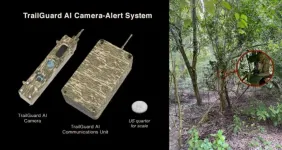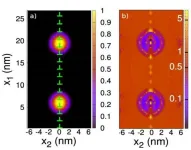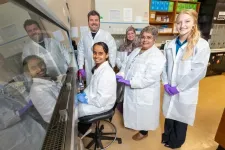The Amazon river basin is known for its immense and lush tropical forests, so one might assume that the Amazon’s land is equally rich. In fact, the soils underlying the forested vegetation, particularly in the hilly uplands, are surprisingly infertile. Much of the Amazon’s soil is acidic and low in nutrients, making it notoriously difficult to farm.
But over the years, archaeologists have dug up mysteriously black and fertile patches of ancient soils in hundreds of sites across the Amazon. This “dark earth” has been found in and around human settlements dating back hundreds to thousands of years. And it has been a matter of some debate as to whether the super-rich soil was purposefully created or a coincidental byproduct of these ancient cultures.
Now, a study led by researchers at MIT, the University of Florida, and in Brazil aims to settle the debate over dark earth’s origins. The team has pieced together results from soil analyses, ethnographic observations, and interviews with modern Indigenous communities, to show that dark earth was intentionally produced by ancient Amazonians as a way to improve the soil and sustain large and complex societies.
“If you want to have large settlements, you need a nutritional base. But the soil in the Amazon is extensively leached of nutrients, and naturally poor for growing most crops,” says Taylor Perron, the Cecil and Ida Green Professor of Earth, Atmospheric and Planetary Sciences at MIT. “We argue here that people played a role in creating dark earth, and intentionally modified the ancient environment to make it a better place for human populations.”
And as it turns out, dark earth contains huge amounts of stored carbon. As generations worked the soil, for instance by enriching it with scraps of food, charcoal, and waste, the earth accumulated the carbon-rich detritus and kept it locked up for hundreds to thousands of years. By purposely producing dark earth, then, early Amazonians may have also unintentionally created a powerful, carbon-sequestering soil.
“The ancient Amazonians put a lot of carbon in the soil, and a lot of that is still there today,” says co-author Samuel Goldberg, who performed the data analysis as a graduate student at MIT and is now an assistant professor at the University of Miami. “That’s exactly what we want for climate change mitigation efforts. Maybe we could adapt some of their indigenous strategies on a larger scale, to lock up carbon in soil, in ways that we now know would stay there for a long time.”
The team’s study will appear in Science Advances. Other authors include former MIT postdoc and lead author Morgan Schmidt, anthropologist Michael Heckenberger of the University of Florida, and collaborators from multiple institutions across Brazil.
Modern intent
In their current study, the team synthesized observations and data that Schmidt, Heckenberger, and others had previously gathered, while working with Indigenous communities in the Amazon since the early 2000s, with new data collected in 2018-19. The scientists focused their fieldwork in the Kuikuro Indigenous Territory in the Upper Xingu River basin in the southeastern Amazon. This region is home to modern Kuikuro villages as well as archaeological sites where the ancestors of the Kuikuro are thought to have lived. Over multiple visits to the region, Schmidt, then a graduate student at the University of Florida, was struck by the darker soil around some archaeological sites.
“When I saw this dark earth and how fertile it was, and started digging into what was known about it, I found it was a mysterious thing — no one really knew where it came from,” he says.
Schmidt and his colleagues began making observations of the modern Kuikuro’s practices of managing the soil. These practices include generating “middens” — piles of waste and food scraps, similar to compost heaps, that are maintained in certain locations around the center of a village. After some time, these waste piles decompose and mix with the soil to form a dark and fertile earth, that residents then use to plant crops. The researchers also observed that Kuikuro farmers spread organic waste and ash on farther fields, which also generates dark earth, where they can then grow more crops.
“We saw activities they did to modify the soil and increase the elements, like spreading ash on the ground, or spreading charcoal around the base of the tree, which were obviously intentional actions,” Schmidt says.
In addition to these observations, they also conducted interviews with villagers to document the Kuikuro’s beliefs and practices relating to dark earth. In some of these interviews, villagers referred to dark earth as “eegepe,” and described their daily practices in creating and cultivating the rich soil to improve its agricultural potential.
Based on these observations and interviews with the Kuikuro, it was clear that Indigenous communities today intentionally produce dark earth, through their practices to improve the soil. But could the dark earth found in nearby archaeological sites have been made through similar intentional practices?
A bridge in soil
In search of a connection, Schmidt joined Perron’s group as a postdoc at MIT. Together, he, Perron, and Goldberg carried out a meticulous analysis of soils in both archaeological and modern sites in the Upper Xingu region. They discovered similarities in dark earth’s spatial structure: Deposits of dark earth were found in a radial pattern, concentrating mostly in the center of both modern and ancient settlements, and stretching, like spokes of a wheel, out to the edges. Modern and ancient dark earth was also similar in composition, and was enriched in the same elements, such as carbon, phosphorus, and other nutrients.
“These are all the elements that are in humans, animals, and plants, and they’re the ones that reduce the aluminum toxicity in soil, which is a notorious problem in the Amazon,” Schmidt says. “All these elements make the soil better for plant growth.”
“The key bridge between the modern and ancient times is the soil,” Goldberg adds. “Because we see this correspondence between the two time periods, we can infer that these practices that we can observe and ask people about today, were also happening in the past.”
In other words, the team was able to show for the first time that ancient Amazonians intentionally worked the soil, likely through practices similar to today’s, in order to grow enough crops to sustain large communities.
Going a step further, the team calculated the amount of carbon in ancient dark earth. They combined their measurements of soil samples, with maps of where dark earth has been found through several ancient settlements. Their estimates revealed that each ancient village contains several thousand tons of carbon that has been sequestered in the soil for hundreds of years as a result of Indigenous, human activities.
As the team concludes in their paper, “modern sustainable agriculture and climate change mitigation efforts, inspired by the persistent fertility of ancient dark earth, can draw on traditional methods practiced to this day by Indigenous Amazonians.”
This research at MIT was supported, in part, by the Abdul Latif Jameel Water and Food Systems Lab and the Department of the Air Force Artificial Intelligence Accelerator. Field research was supported by grants to the University of Florida from the National Science Foundation, the Wenner-Gren Foundation and the William Talbott Hillman Foundation, and was sponsored in Brazil by the Museu Goeldi and Museu Nacional.
###
Written by Jennifer Chu, MIT News
END





